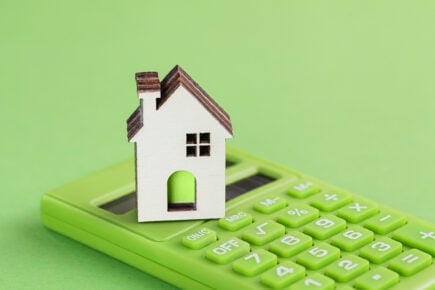If you own a home in Ontario and are more than 55 years old, you could qualify for a reverse mortgage, a type of loan based on your home equity. A reverse mortgage could allow you to tap into the equity you’ve built without selling your property or going through refinancing.
What is a reverse mortgage?
A reverse mortgage is a loan that allows homeowners to tap into their home equity without selling the home.
Reverse mortgages come with some important fine print. You must be 55 older, and you can borrow up to 55% of the value of the home. The amount borrowed is tax-free, and you retain ownership of your home. You won’t need to repay the reverse mortgage until you move off the property, sell the property or die (in which case, your estate would pay back the loan).
Types of reverse mortgages
The types of reverse mortgage you can get are similar to the types of traditional mortgages. Generally, you’ll be able to choose from terms ranging from six months to five years, and choose between a variable or fixed interest rate.
Who offers reverse mortgages in Ontario?
In all of Canada, only two financial institutions provide reverse mortgages: HomeEquity Bank and Equitable Bank. Both offer reverse mortgages in Ontario.
HomeEquity Bank’s reverse mortgage product (called the CHIP Reverse Mortgage) is available in all 10 provinces, but not in any of the territories. You can call them directly or contact them via your financial advisor.
Equitable Bank is the only other reverse mortgage provider in Ontario, but only offers reverse mortgages in major urban centres. If you’re not sure whether your location qualifies, you’ll need to contact Equitable Bank directly to find out. You can get a reverse mortgage quote online or by phone.
What is the CHIP Reverse Mortgage?
The CHIP Reverse Mortgage is offered by HomeEquity Bank and is Canada’s most popular reverse mortgage. It was launched in 1986 and was originally known as the Canadian Home Income Plan (CHIP). It was developed to allow seniors to stay in their homes and tap into their home equity while retaining ownership of the property.
How does a reverse mortgage work in Ontario?
Reverse mortgages are quite straightforward, though it’s wise to pay special attention to things like fees, interest rates and repayment requirements to ensure you understand what you’re agreeing to do.
Eligibility
The eligibility requirements for a reverse mortgage are not as stringent as they are for a traditional mortgage because the lender is mainly interested in your age and the value of your home.
To be eligible for a reverse mortgage, you must own a home that you use as your primary residence. You and any other owners listed on your property’s title must be at least 55 years old. You’ll also need to have lived in the home for at least six months and may be required to get independent legal advice.
Your home must also be worth more than the lender’s minimum threshold. Both HomeEquity Bank and Equitable Bank require that your home is appraised at $250,000 or more.
Application process
The process varies slightly by lender, but generally, you would contact the lender by phone to ask about the application process and confirm that you are eligible. If you’re interested in the CHIP reverse mortgage, you can also request a quote and check your eligibility online.
If you want to proceed, you’d need to get your property appraised to confirm its value, which the lender will use along with your age, location and other factors to determine the amount you’re able to borrow. You would then choose your type of interest rate and term. Your lender may also want you to get legal advice to make sure a reverse mortgage is the right fit for your financial needs.
Interest rates and fees
Depending on your lender and your qualifications, you can choose between a variable or fixed rate for your reverse mortgage. You may need to pay appraisal costs, legal fees and closing costs.
How reverse mortgage funds are disbursed
You can choose to receive your funds in one lump-sum payment or as periodic payments.
Paying back a reverse mortgage
With a reverse mortgage, you don’t have to make regular payments. You’ll need to pay back the amount you borrowed, plus accrued interest, when you move or sell the property. For example, if you move into a long-term care facility and no longer live in your home, you’ll need to repay the reverse mortgage.
If you live in the home until you die, your estate is responsible for paying off the reverse mortgage, typically by selling the property.
Are reverse mortgages a good idea in Ontario?
A reverse mortgage can be a smart way to access the equity in your home without having to sell the property. This option can be especially handy if you have limited cash savings but own a valuable property that you don’t want to sell.
A reverse mortgage allows you to convert your home’s accumulated equity into cash, which you can then use to fund projects like renovations or travel — or even a second home down south to escape cold Ontario winters.
Note that if you plan to become a snowbird, you’ll need to read the fine print about how many days per year you need to live in the home that secures your reverse mortgage so it remains your primary residence.
Reverse mortgages are best for those who… | Reverse mortgages are wrong for those who... |
|---|---|
|
|
Questions to ask before applying for a reverse mortgage in Ontario
When considering a reverse mortgage, it is crucial to ask your lender about:
- Disbursement options. Find out what your contract will look like if you decide to receive funds as a lump sum or as monthly payments.
- Fees and costs. Be very clear about all the fees associated with your reverse mortgage.
- Interest rate. Ask about the interest rate and whether it is fixed or variable.
- Loan default situations. Clarify the conditions that could cause you to default on the loan, such as failing to pay your property taxes.
- Early repayment penalties. Check if there are any penalties for selling your home within a certain amount of time after taking out a reverse mortgage.
- Repayment terms. Discuss how much time you’ll have to pay off the reverse mortgage if you move, or how much time your estate will have to pay it off if you pass away.
- Negative equity protection. Ask if there is some protection in place to ensure you don’t wind up owing more than your home is worth when it’s time to repay the loan, such as if property values decline.
- How it could affect other financing opportunities. Check whether the reverse mortgage could make it harder to get a home equity line of credit (HELOC) or co-sign on a traditional mortgage to help your children buy a home.
Alternatives to a reverse mortgage
If you need to access funds but feel hesitant about getting a reverse mortgage, consider alternatives like selling your home and downsizing, or applying for a HELOC.
Pros and cons of reverse mortgages
Here are some pros and cons to consider before getting a reverse mortgage:
Pros
- You don’t need to make regular mortgage payments.
- You can access your home’s equity without selling it, so you can stay in your home.
- Funds from a reverse mortgage are tax-free.
- Your Old-Age Security (OAS) or Guaranteed Income Supplement (GIS) benefits are not impacted.
- You can decide how you want to receive your loan payment.
- You don’t need to repay the funds you borrow until you move, sell the home or die.
Cons
- Costs and interest rates for a reverse mortgage are generally higher than they are for a traditional mortgage.
- Your choices are limited to two companies that offer reverse mortgages, so there’s not much competition.
- Your home equity will decrease as you borrow more funds and accrue interest.
- If you don’t pay off your reverse mortgage before you die, your estate will need to repay the funds plus interest, which will leave less money for your beneficiaries.
Frequently asked questions about getting a reverse mortgage in Ontario
As long as you own the condo outright and are 55 or older, you can take out a reverse mortgage on a condo in Ontario. Your condo must also be appraised as being worth at least $250,000.
Two financial institutions offer reverse mortgages in Ontario: HomeEquity Bank (CHIP Reverse Mortgage) and Equitable Bank. However, Equitable Bank’s reverse mortgage is only available in urban centres, so you may need to confirm whether your town meets the criteria.
DIVE EVEN DEEPER

What Is a Home Equity Loan?
A home equity loan, also known as a second mortgage or add-on mortgage, lets you borrow against the value of your home.

Guide to Refinancing a Mortgage in Ontario
What to consider before refinancing your mortgage in Ontario, from how much you could access to what it might cost.

Today’s Best Mortgage Rates in Ontario
Compare customized mortgage rates from Canada’s top lenders. Find the best fixed or variable mortgage rate for your needs.

HELOC: What It Is and How It Works
A home equity line of credit, or HELOC, allows you to borrow money using your home equity as collateral. HELOC’s are variable rate loans with interest-only payments.

